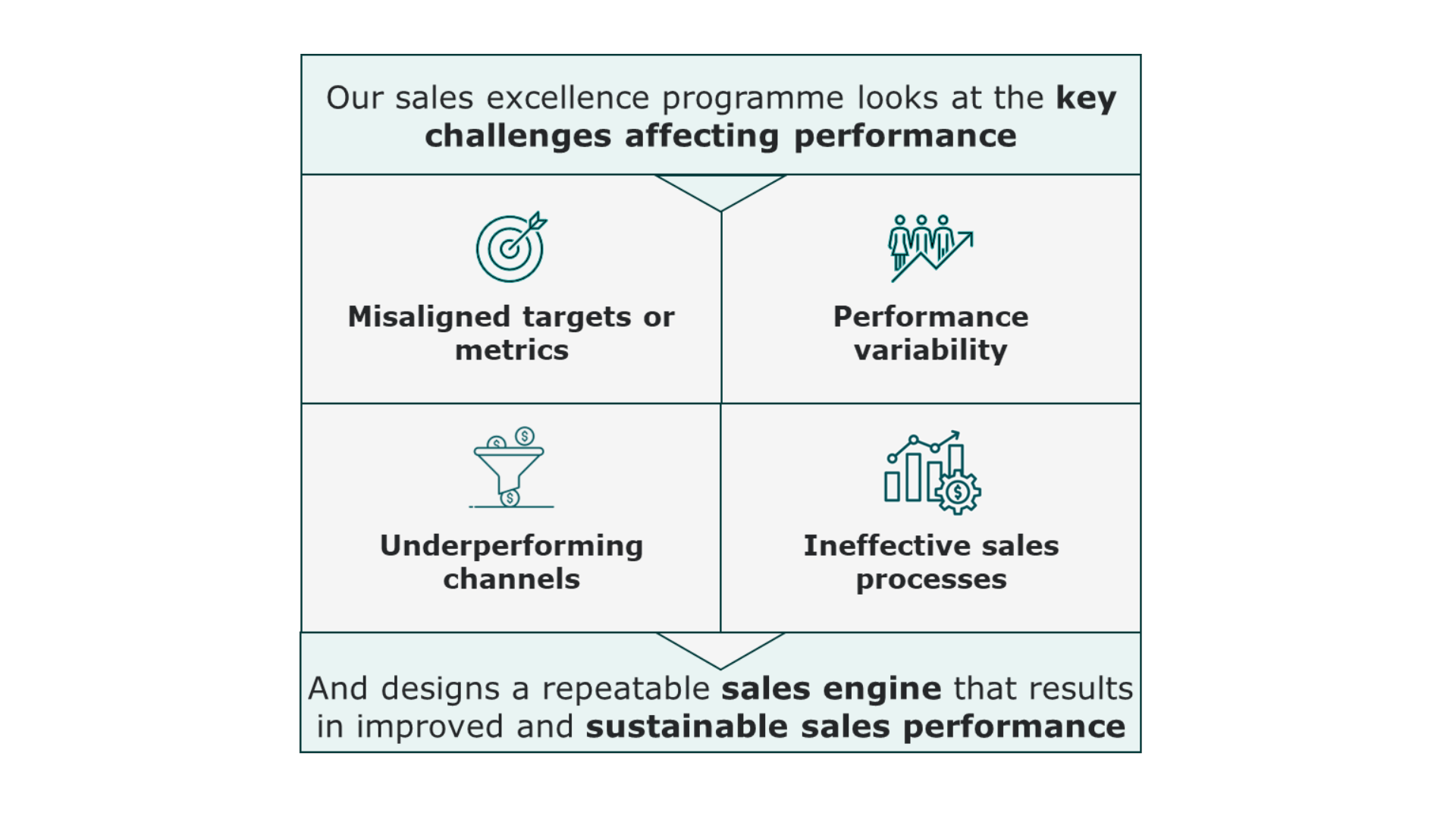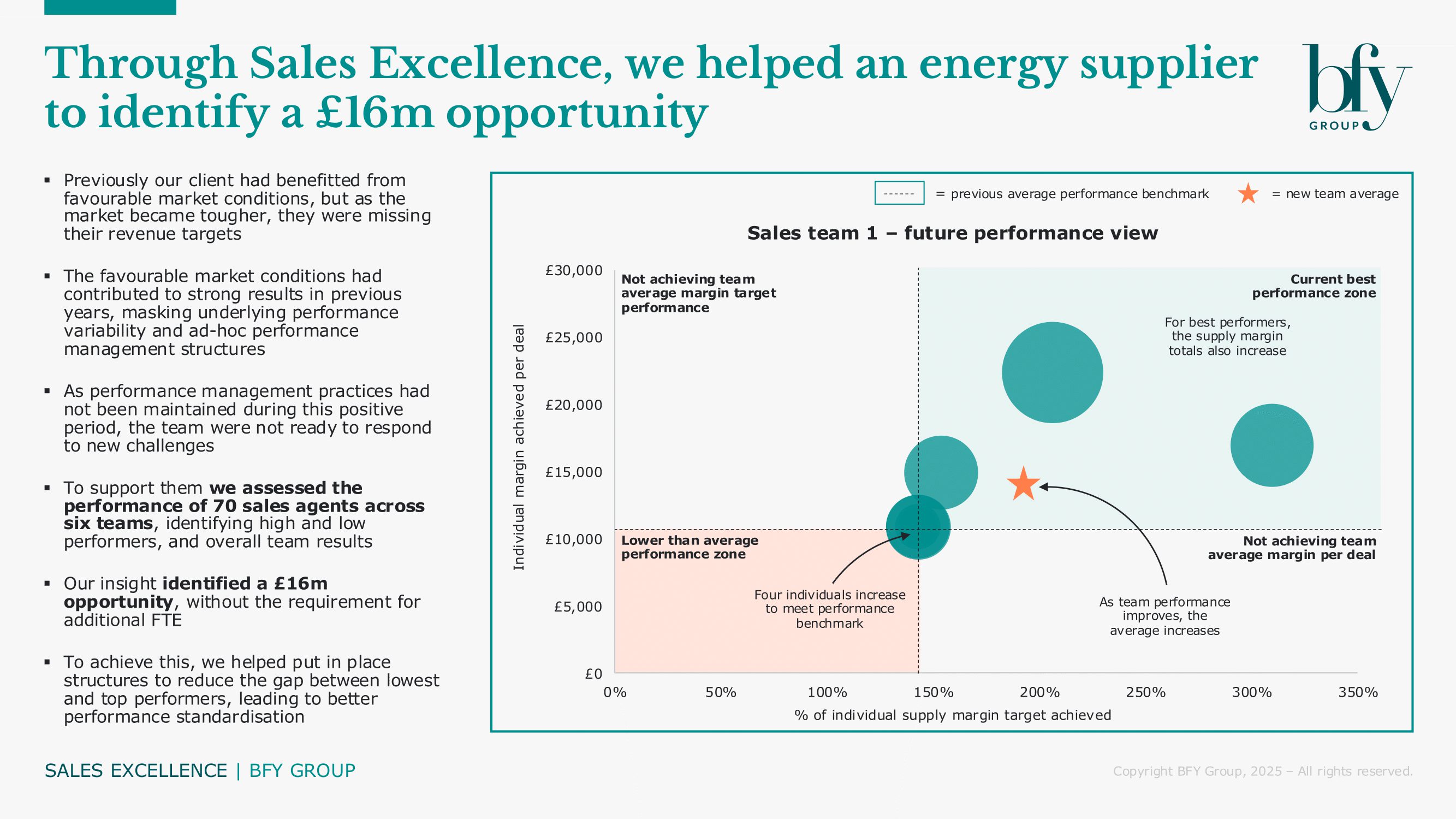The B2B energy market is changing.
Suppliers are rethinking how they work with TPIs after the non-domestic market review. Longer-term contracts are emerging across segments, increasing their prevalence beyond I&C. And customer buying cycles are growing.
Sales processes that once worked well are now showing signs of strain. It’s why we’re increasingly working with clients on what they can do now to drive in-year improvements, while also building the capabilities and processes needed to underpin sustained success in the years ahead.
It’ll come as no surprise that it’s easy to lose focus on the key areas that affect sales, particularly during longer-term innovation or digital transformations. In our previous article about hidden gaps undermining B2B energy profits, we shared four of the most common areas that influence sales performance for suppliers (see below). We also posed questions to help you assess your own performance.
Now, we’ll move from assessment to action.
- Misaligned targets or metrics
- Individual and team performance variability
- Underperforming sales channels
- Ineffective sales processes

To put things into perspective, we helped one client discover ~£16m in potential gross margin by addressing these four performance challenges with our sales excellence offering. Here’s how you can improve your sales performance.
Four steps to achieving sales excellence
First things first. You don’t need a total overhaul to make meaningful improvements. Focusing on these four areas will make incremental improvements in a few weeks and months.
These steps use your existing resources - fine-tuning and improving what you’ve got.
1) Aligning targets and metrics
You might see targets as the result, but targets should form the base from which your teams’ performance grows. Otherwise, even high-performing advisors might be unwittingly working against the overall business strategy.
Make sure your targets align with your strategy. Design a key performance indicator (KPI) tree or use objectives and key results (OKRs) to map out each team’s targets. Then add in the business objectives, and identify any gaps or overlaps.
These maps can also help you explain the bigger picture to advisors. Understanding targets is important for accountability. Everyone should understand how they contribute to business success.
We often see targets set in isolation, or they’ve grown without strong links to data. Sometimes collective targets don't hit the business objectives, or they can exceed them. This can lead to some teams chasing opportunities that hinder overall profitability.
Yes, targets need to be ambitious, but never forget the data. Targets should balance past internal results against the external lenses of competitor performance and future market expectations. Taken together, these will identify new opportunities for growth.
For example, if a company’s historic performance, or share of switches, has been low in comparison to its competitors, the consideration of the external factors will identify this opportunity for improvement. Taken as a whole, it’s harder to balance stretch with achievability when targets aren’t based on both internal and external data points.
2) Tackling performance variability
While it's natural to have high performers, excessive variability often signals untapped potential or a skills gap in your broader team.
Use data to identify any obvious signs of performance variability. You can see more obvious signs of performance variability and effectiveness across teams and members with on-the-ground observations.
Big variations in task time are usually a result of unclear expectations. Work with your leaders to understand how they’re setting expectations, then revisit step one to address the issue.
High performers can mask underlying issues within teams and across your organisation. They might ‘carry’ underperforming colleagues. Rather than just celebrating your high flyers, try to understand what makes them successful, then equip the rest of the team with those tools for success.
Successful performance management includes regular and meaningful one-to-ones for all team members. Review individual performance and have conversations about their contributions. It’s also important to allocate sufficient time for leaders to review performance regularly and then provide support to teams or individual members.
3) Refocusing underperforming channels
Continually review your sales channels. What worked well two years ago might not work today. The market, customer expectations, team members and business objectives fluctuate, so it’s important to be prepared to shift accordingly.
Review your channel performance regularly and act as needed. Which channel is showing more signs of promise? Which is demanding more time for lower conversions? Instead of dramatic changes, small adjustments to channel strategy can produce significant improvements.
To pinpoint where you need to scale back or make a ‘big-bet’ to focus your attention on, tap into your existing knowledge base. Ask for data from your Insights, Marketing, and Strategy teams to see the fuller picture. Share your knowledge of customer and partner conversations, or emerging themes, to help identify how the market’s changing. Your sales team is often the first to spot trends, shifting customer priorities or new competitive threats. This intelligence can be invaluable for strategic decision-making. And this collaboration will benefit all areas of your organisation.
4) Refining sales processes
Inefficiencies easily creep in if processes aren’t reviewed regularly. Bad habits are easy to make but harder to break. Teams often develop quick fixes to solve problems, which may create bigger issues elsewhere.
Ensure your data is end-to-end and cross-channel. Siloed data will never give you the full picture. We often find that organisations have excellent visibility of individual team performance but struggle to understand how prospects progress through the entire sales journey.
To get the insights you need, complete process mapping or value-chain exercises with your teams. Together you can highlight the key challenges or areas of opportunity, uncover the contributing factors and then find the most suitable resolution. We find that the most positive and effective process improvements are driven from the frontline, instead of top-down redesigns.
Taking action and building momentum for sales growth
Sales excellence doesn't happen overnight, but it doesn't need a revolution either. The key is continually reviewing and improving, with incremental changes across the organisation. This approach helps to produce sustainable performance improvement. Performance assessment and improvements will become embedded in how your organisation operates.
The strongest results come from those organisations that approach these four steps of sales excellence systematically. They address fundamental issues before layering on more complex initiatives. Whether it’s leadership training to manage and encourage better performance, or sharing frustrations, ideas and opportunities from customer-facing colleagues.
Support to improve your sales potential
Sometimes a fresh perspective is all that’s needed. When we helped find ~£16m in potential gross margin for one of our clients, they weren’t doing anything particularly wrong, but they needed the opportunity to step back and assess things comprehensively.

Our team has extensive experience leading SME and B2B sales functions at major UK energy retailers, and we understand the unique challenges facing today's market. We support utility companies, combining our deep industry expertise with our transformational practices and a collaborative approach.
We can help with:
- Shaping strategies to unlock commercial value
- Developing products to increase sales performance
- Driving performance through structured performance management
- Optimising operations and back-office processes to increase efficiency and enable scale
If you’d like to know more about our Sales Excellence offering, and how it could address your specific challenges and opportunities, contact Hannah Sword.
Hannah Sword
Director
Hannah leads client engagements, striving to ensure clients gain significant value and benefits and from the work we deliver.
View Profile

